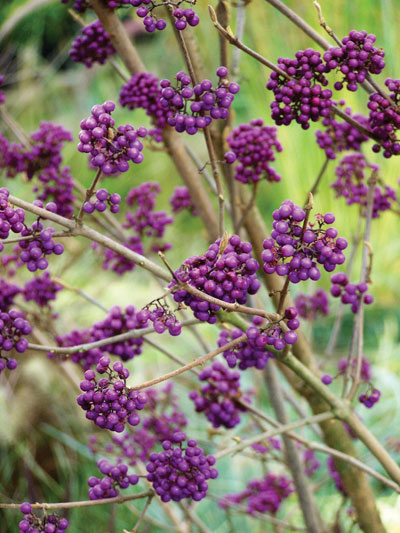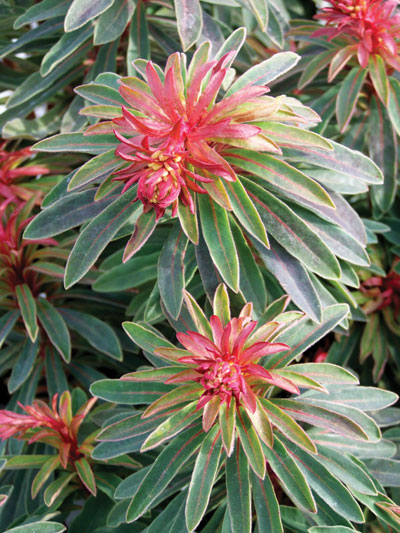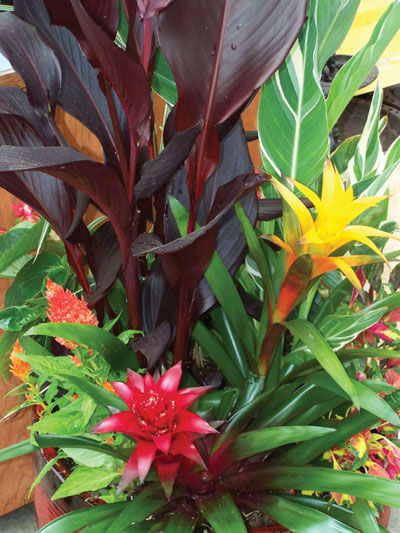
We live in a world that demands instant access to information – where Twitter, Facebook and text messaging dominate the collective attention of the younger generation. As a result, the retail sector has also become a visual marketplace, meaning that impulse sales or ‘buying what we see’ is quickly becoming the norm.
We live in a world that demands instant access to information – where Twitter, Facebook and text messaging dominate the collective attention of the younger generation.
 |
 |
 |
 |
| (Clockwise starting from top left) Themed end-caps draw attention to products and show customers how to display them; wow your customers with seasonal colour by using Callicarpa ‘Profusion’ or Beauty Berry; container gardens like this sample summer planter of Canna lilies, bromeliads, celosia and amaranthus appeal to gardeners with both large and small properties; and varieties like Euphorbia x martinii ‘Rudolph’ bring a garden centre to life during the winter months. Advertisement
|
|
As a result, the retail sector has also become a visual marketplace, meaning that impulse sales or ‘buying what we see’ is quickly becoming the norm. This change in purchasing habits dictates that garden centres need to make adjustments in order to capitalize on this trend and connect with this next wave of consumers. With that in mind, here are a few concepts that I have implemented over the past few years:
Simple solutions end caps
Themed end caps are an excellent way of providing useful information while also promoting self-service sales. Some relevant topics include ‘Deer Resistant Plants’, ‘Hummingbird Flowers’ or ‘Plants that Attract Butterflies’ as well as shade tolerance, drought resistance or any group of plants your customers seem to be enquiring about on a regular basis. Your end cap plant selections will need to have attractive foliage or flowers in order to garner attention, with the theme serving to seal the deal, as far as sales are concerned.
Brochures can also be helpful here, but they often confuse customers with extensive lists of plants that may or may not be in stock at that time. The other catch 22 is that some people will insist on seeing everything on the list, which can really tie-up sales staff.
Selling through seminars
Seminars are an effective means of marketing directly to a captive audience. Yes, these are people who have come (and in some instances, paid) to learn something about gardening, but never forget that they are also potential customers. The key is to give them what they want, which are easy solutions to make their home landscape more attractive. This makes the seminar title or topic very critical in regards to attracting the right clientele. Two of the most successful seminars I have taught were ‘I Want Everything’ (a design seminar focusing on multi-use landscaping) and ‘Four-Season Container Gardening’ with the planter seminars in particular always resulting in brisk sales immediately afterwards. The key here is to take the time to organize and create inspiring (but easy to duplicate) containers with plants that you actually have in stock and to have ample staff available after the seminar to quickly direct clients to their desired purchases.
Sample planters
Container culture represents the best potential for growth in sales given the fact that regardless of schedule, lot size or budget, every gardener has the time and room for a planter or two. In my experience, it is not the sample planters as a whole that generate the most sales but the actual ingredients used – the plants, pots, fertilizers and soils. So it is best to vary the sample planters using different coloured pots and diverse plant material in order to create the broadest appeal. Having them situated in high traffic areas near the front of the store is also critical, because they are of no use when tucked in an out of sight corner.
Keeping it seasonal
Garden centres should always be a showcase of seasonal colour. By way of example the garden centre I manage is currently fully stocked with berried plants (Callicarpa ‘Profusion’, lingonberry, Ilex verticillata, wintergreen), hellebores (25 different species or cultivars), winter-flowering shrubs (witch hazel, Viburnum x bodnantense ‘Dawn’, Corylopsis) and evergreen perennials such as heuchera, Euphorbia ‘Rudolph’ and ornamental grasses, including Carex ‘Evergold’. Even in the supposed ‘off’ season, having a garden centre filled with dormant plants or bare shrubs is hardly going to inspire those winter or early spring sales. After all, the customer should only be expected to buy when you show them that you are actually ready to sell them seasonally relevant products.
An eye to the future
What is the average age of your typical customer and are they spending more or less as the years pass? Older clientele (55 years and up) tend to have well established gardens, are less prone to impulse sales and will probably downsize to an apartment or condominium for their retirement years. Your future sales will depend on you attracting the next generation of homebuyers and young families. Failing to do this will only result in declining market share. The danger here is not just a lighter cash flow but also the potential for diminished access to credit to grow your business or weather a temporary financial shortfall.
Your best approach here is to be a family friendly nursery with helpful staff and events specifically geared towards this demographic. Colouring contests for the kids, flower-arranging seminars for the wives, family events (ie. an Easter egg hunt or pumpkin decorating contest) during holidays all work well to help connect your garden centre to those future customers.
Print this page